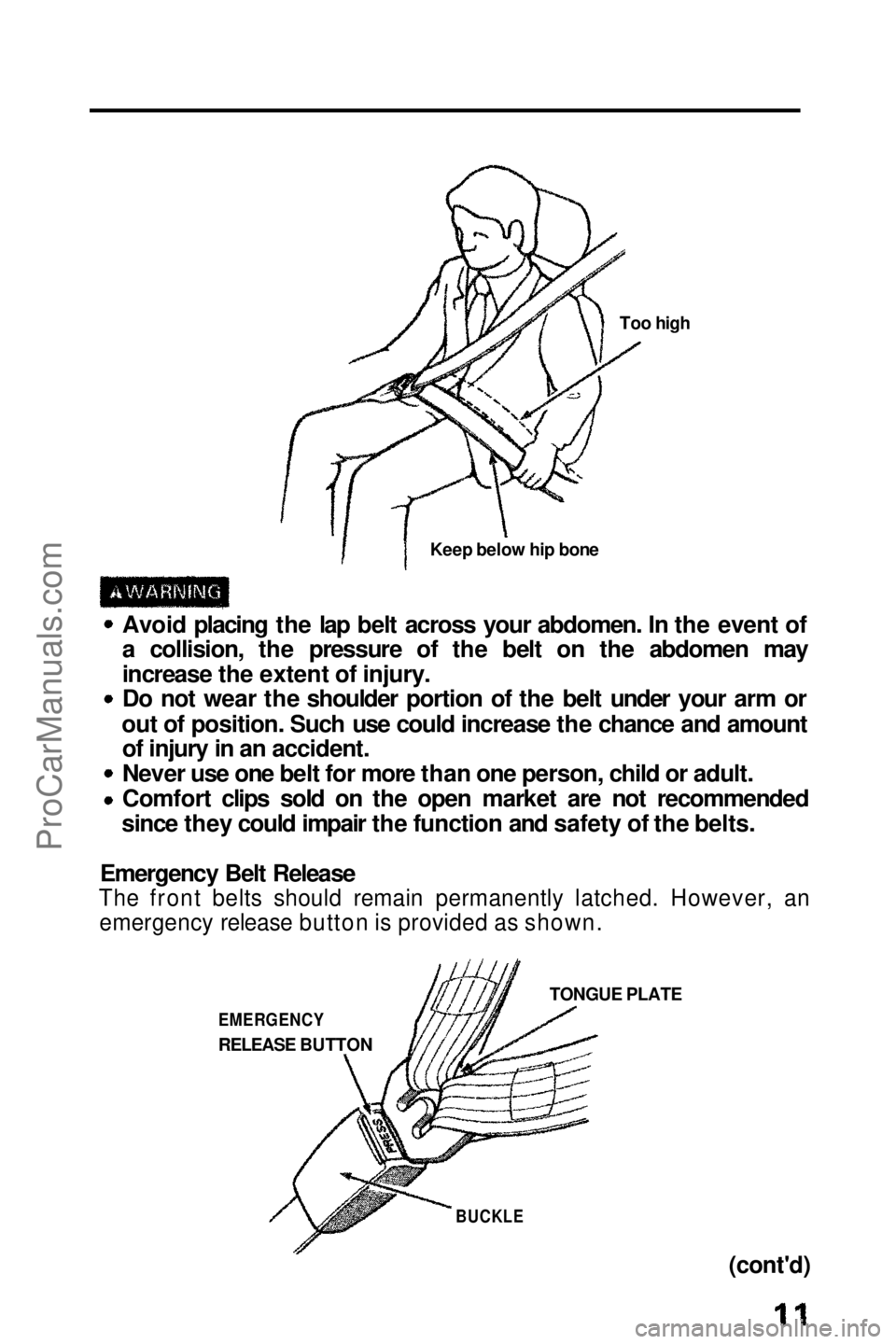Page 9 of 143
Trunk Access from Rear Seat
The rear seat-back can be opened by turning the lock on the rear
shelf with the master key and pulling down with the strap at the top
of the seat-back. This allows passenger access to the trunk and makes it possible to carry long objects inside the car.
The rear seat-back can also be released from inside the trunk by
pulling the release.
When closing the rear seat trunk access, push the seat-back firmly into place, then pull on the strap to make sure it is secure.
Passengers or pets must not sit on the folded portion of the rear
seat. Make sure any luggage or cargo within the trunk, or extending
through the rear seat trunk access is secured. Make sure the seat-back latches engage securely when the
seat-back is returned to its normal position.
RELEASE
MASTER KEY STRAPProCarManuals.comMain Menu t s
Page 10 of 143
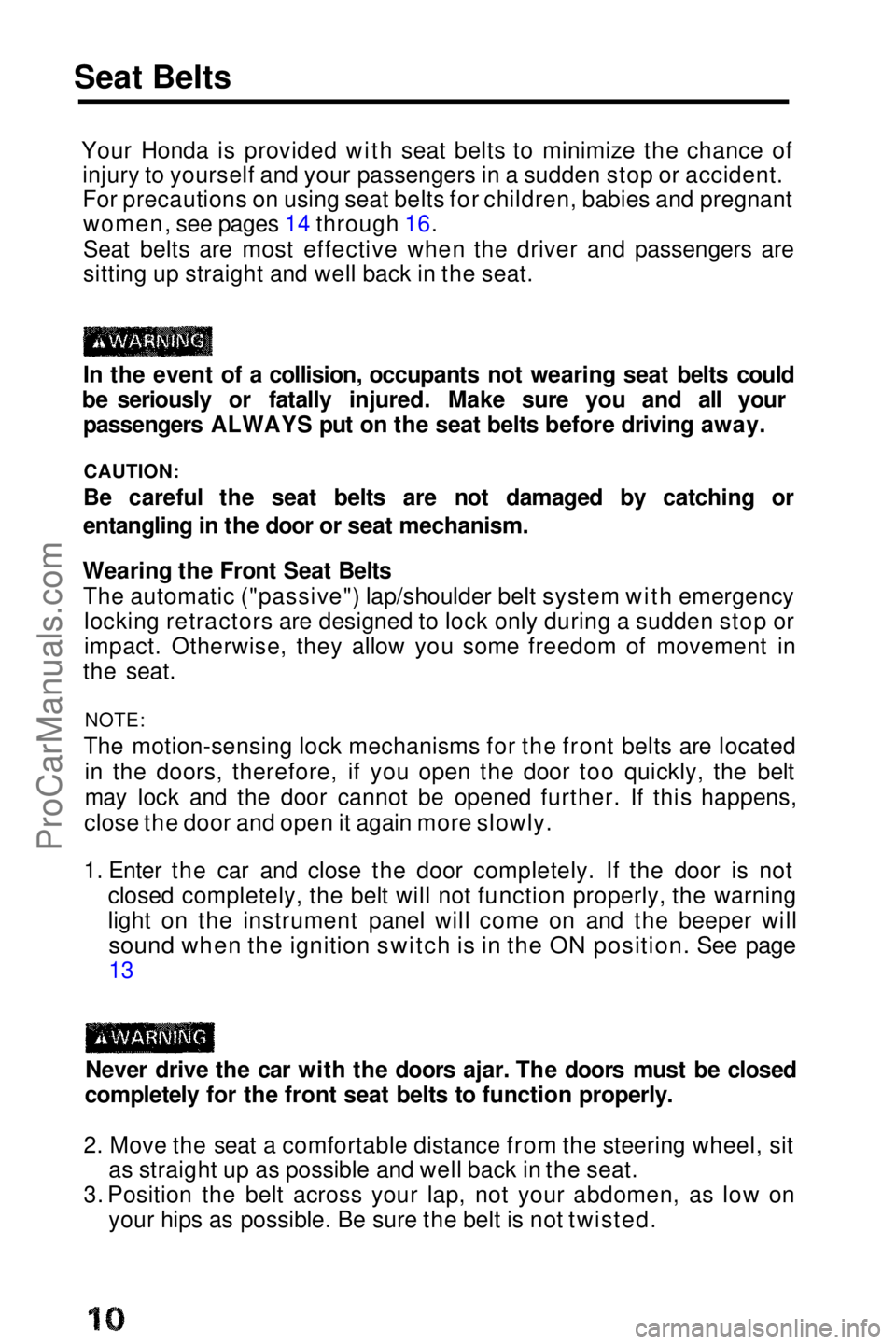
Seat Belts
Your Honda is provided with seat belts to minimize the chance ofinjury to yourself and your passengers in a sudden stop or accident.
For precautions on using seat belts for children, babies and pregnantwomen, see pages 14 through 16.
Seat belts are most effective when the driver and passengers are
sitting up straight and well back in the seat.
In the event of a collision, occupants not wearing seat belts could
be seriously or fatally injured. Make sure you and all your passengers ALWAYS put on the seat belts before driving away.
CAUTION:
Be careful the seat belts are not damaged by catching or
entangling in the door or seat mechanism.
Wearing the Front Seat Belts The automatic ("passive") lap/shoulder belt system with emergency locking retractors are designed to lock only during a sudden stop or
impact. Otherwise, they allow you some freedom of movement in
the seat.
NOTE:
The motion-sensing lock mechanisms for the front belts are located in the doors, therefore, if you open the door too quickly, the belt
may lock and the door cannot be opened further. If this happens,
close the door and open it again more slowly.
1. Enter the car and close the door completely. If the door is not closed completely, the belt will not function properly, the warning
light on the instrument panel will come on and the beeper will
sound when the ignition switch is in the ON position. See page
13
Never drive the car with the doors ajar. The doors must be closed
completely for the front seat belts to function properly.
2. Move the seat a comfortable distance from the steering wheel, sit as straight up as possible and well back in the seat.
3. Position the belt across your lap, not your abdomen, as low on your hips as possible. Be sure the belt is not twisted.ProCarManuals.comMain Menu t s
Page 11 of 143
Too high
Keep below hip bone
Avoid placing the lap belt across your abdomen. In the event of
a collision, the pressure of the belt on the abdomen may
increase the extent of injury.
Do not wear the shoulder portion of the belt under your arm or
out of position. Such use could increase the chance and amount of injury in an accident.
Never use one belt for more than one person, child or adult.
Comfort clips sold on the open market are not recommended
since they could impair the function and safety of the belts.
Emergency Belt Release
The front belts should remain permanently latched. However, an
emergency release button is provided as shown.
(cont'd)
TONGUE PLATE
BUCKLE
EMERGENCY
RELEASE BUTTONProCarManuals.comMain Menu t s
Page 12 of 143
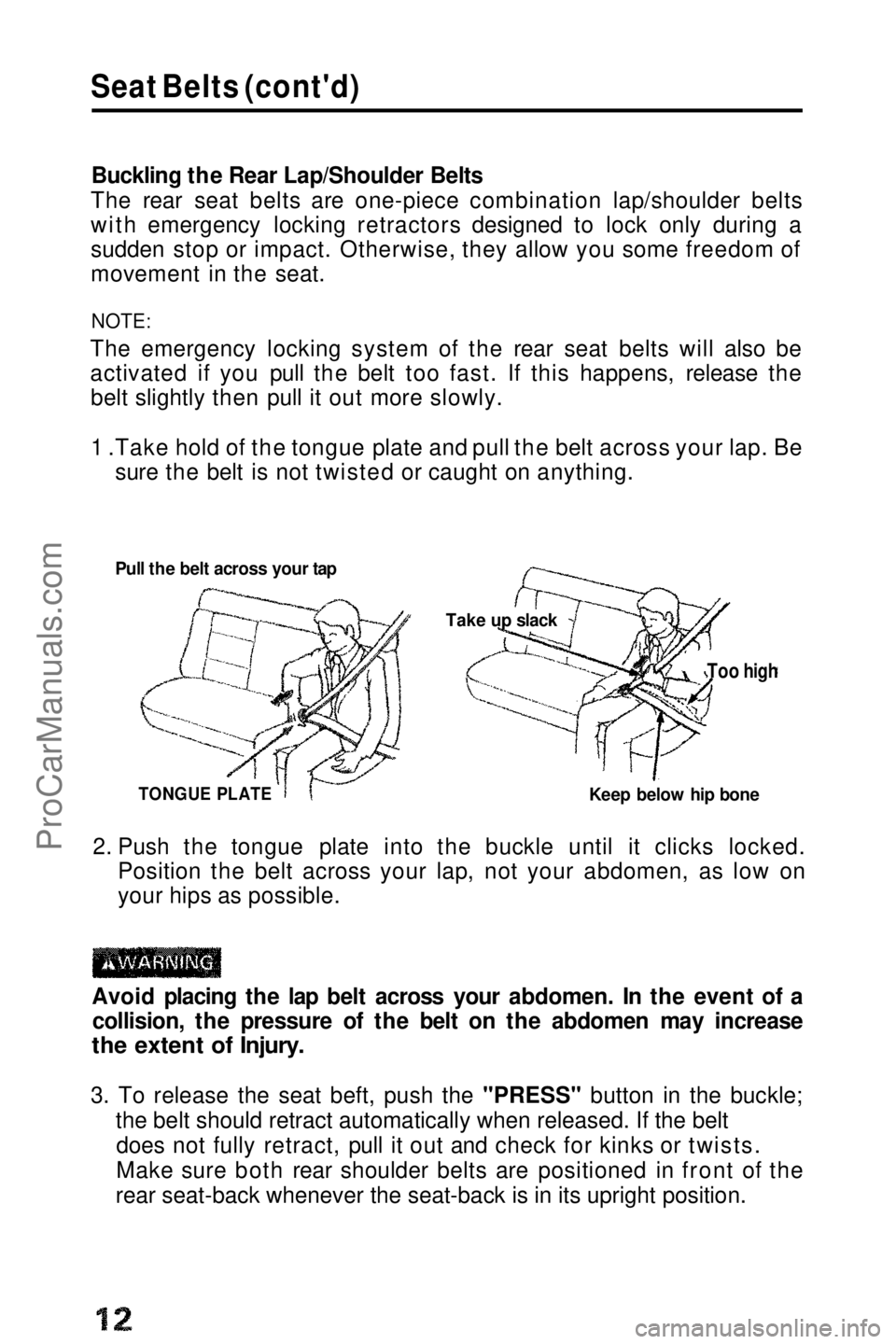
Seat Belts (cont'd)
Buckling the Rear Lap/Shoulder Belts
The rear seat belts are one-piece combination lap/shoulder belts
with emergency locking retractors designed to lock only during a
sudden stop or impact. Otherwise, they allow you some freedom of
movement in the seat.
NOTE:
The emergency locking system of the rear seat belts will also be
activated if you pull the belt too fast. If this happens, release the belt slightly then pull it out more slowly.
1 .Take hold of the tongue plate and pull the belt across your lap. Be sure the belt is not twisted or caught on anything.
Pull the belt across your tap
2. Push the tongue plate into the buckle until it clicks locked. Position the belt across your lap, not your abdomen, as low on
your hips as possible.
Avoid placing the lap belt across your abdomen. In the event of a collision, the pressure of the belt on the abdomen may increase
the extent of Injury.
3. To release the seat beft, push the "PRESS" button in the buckle;
the belt should retract automatically when released. If the belt
does no
t fully retract, pull it out and check for kinks or twists.
Make sure both rear shoulder belts are positioned in front of the
rear seat-back whenever the seat-back is in its upright position.
Too high
Keep below hip bone
Take up slack
TONGUE PLATEProCarManuals.comMain Menu t s
Page 13 of 143
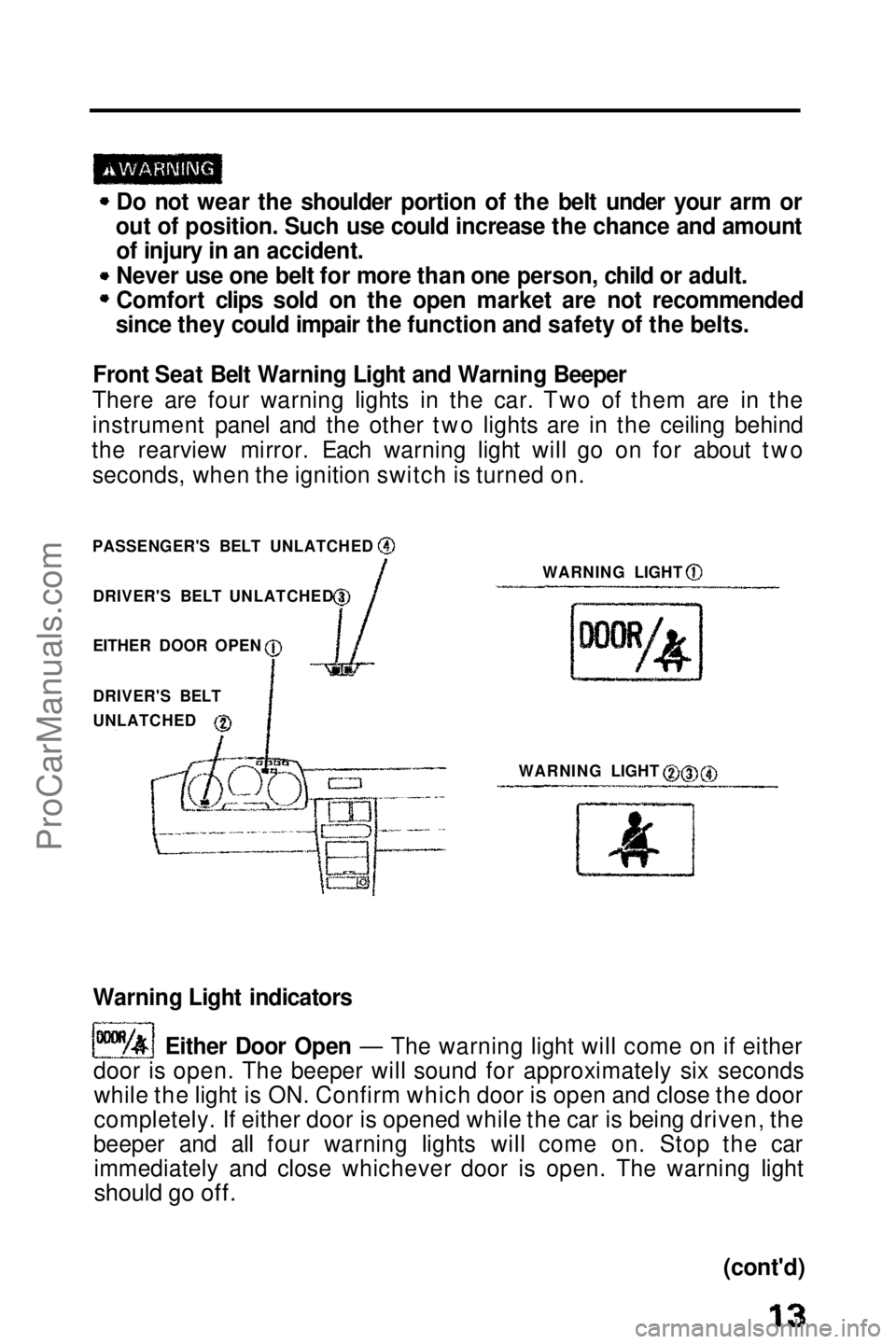
Do not wear the shoulder portion of the belt under your arm or
out of position. Such use could increase the chance and amount of injury in an accident.
Never use one belt for more than one person, child or adult.
Comfort clips sold on the open market are not recommended
since they could impair the function and safety of the belts.
Front Seat Belt Warning Light and Warning Beeper
There are four warning lights in the car. Two of them are in the
instrument panel and the other two lights are in the ceiling behind
the rearview mirror. Each warning light will go on for about two seconds, when the ignition switch is turned on.
WARNING LIGHT
WARNING LIGHT
Warning Light indicators Either Door Open — The warning light will come on if either
door is open. The beeper will sound for approximately six seconds while the light is ON. Confirm which door is open and close the door
completely. If either door is opened while the car is being driven, the
beeper and all four warning lights will come on. Stop the car immediately and close whichever door is open. The warning light
should go off.
(cont'd)
PASSENGER'S BELT UNLATCHED
DRIVER'S BELT UNLATCHED
EITHER DOOR OPEN
DRIVER'S BELT
UNLATCHEDProCarManuals.comMain Menu t s
Page 14 of 143

Seat Belts (cont'd)
Driver's Belt Unlatched — The warning lights will come on if
the driver's seat belt is not latched. The beeper will sound for approximately six seconds while the light is ON, Relatch the belt;
the light should go off.
Front Passenger's Belt Unlatched — The warning light will
come on if the passenger's belt is not securely latched, the beeper
will sound for approximately six seconds. Relatch the belt; the light
should go off.
If the lights and beeper do not function at all or if they come on
even with the belts latched and doors fully closed, it indicates a
malfunction in the seat belt system. In the event of a collision,
severe personal injury could result. The system should be checked immediately by an authorized Honda dealer.
Child Restraint
Children riding in the car should be restrained to minimize the risk ofinjury in an accident, sudden stop or sudden maneuver.
According to accident statistics provided to the National Highway
Traffic Safety Administration (NHTSA), children are safer when properly restrained in the rear seating positions than in the front
seat Larger children should use one of the seat belts provided. For smaller children, we strongly recommend the use of a
commercially available child restraint system that meets the Federal Motor Vehicle Safety Standard (FMVSS) because it offers the most protection against injury. All states now have laws which require
that small children must be seated in a child passenger seat restraint system. Check local laws.
Before buying a particular child restraint system, make sure it fits
your car seat and seat belts, and fits your child. Follow all the
instructions that come with the system.ProCarManuals.comMain Menu t s
Page 15 of 143

Children should never ride unrestrained in an automobile.
Never use an infant carrier or child safety seat that "hooks"
over a seat-back; it may not provide adequate security in an
accident.
Never allow a child to be held in a person's arms while they are
in the moving vehicle. Holding a child in a moving vehicle does
not provide the child with any means of protection during an
accident, even if the person holding the child is wearing a seat
belt.
Installation of Child Seat
All child restraint systems are designed to be secured by lap belts or
the lap belt portion of a lap-shoulder belt. Children could be endangered in a crash, if their child restraints are not properly
secured. Follow the child seat manufacturer's instructions wheninstalling the seat.
Your Honda automobile is equipped with attachment points specifically for a rear seat mounted child restraint system which
uses a top tether.
The tether attachment points are located on the rear tray, just
behind the rear seat-back.
TETHER ATTACHMENTPOINTS
The automatic lap/shoulder restraint system at the front passenger seat cannot be used to secure a child restraint system. Instead, an
optional lap belt must be installed specifically for securing a childrestraint system. Two anchor points have been provided behind the
front passenger seat for installation. The optional lap belt is available
from your Honda dealer.
(cont'd)ProCarManuals.comMain Menu t s
Page 16 of 143

Seat Belts (cont'd)
ANCHOR
POINTANCHOR POINT
To Install A Child Seat
1. Remove the anchor point plugs with a coin or a screw-
driver and
install the optional
lap belt with the fasteners
that came with the belt.
2. Once the optional lap belt is installed, follow the instructions
that came with the child
restraint system for proper
attachment.
Do not use the automatic lap/shoulder belt to secure the child
seat. It will not give enough protection to the child seat and the
child on It.
The optional lap belt is for a child seat only. Do not use it for any
other purpose.
When the child restraint system is not in use, remove it from
the car or secure it with the seat belt to keep it from becoming a projectile in the event of an accident.
NOTE:
See your Honda dealer for installation of the optional lap belt or
the child restraint system.
When not in use, make sure the optional lap belt does not get caught in the passenger's door or seat mechanism.
Pregnant Women
A pregnant woman should use either the front or rear lap/
shoulder belt to help lessen the chance of injury and/or the amount of injury in an accident.
It is desirable that a pregnant woman ask her doctor at each medical check-up if she can drive, and also ask about the most
appropriate way of wearing the lap/shoulder belt.
PLUGSProCarManuals.comMain Menu t s
 1
1 2
2 3
3 4
4 5
5 6
6 7
7 8
8 9
9 10
10 11
11 12
12 13
13 14
14 15
15 16
16 17
17 18
18 19
19 20
20 21
21 22
22 23
23 24
24 25
25 26
26 27
27 28
28 29
29 30
30 31
31 32
32 33
33 34
34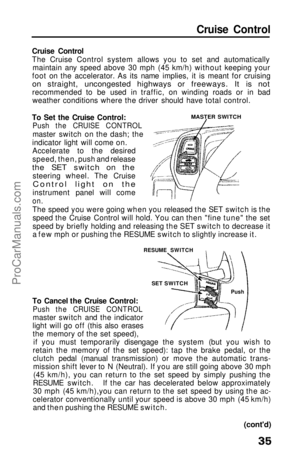 35
35 36
36 37
37 38
38 39
39 40
40 41
41 42
42 43
43 44
44 45
45 46
46 47
47 48
48 49
49 50
50 51
51 52
52 53
53 54
54 55
55 56
56 57
57 58
58 59
59 60
60 61
61 62
62 63
63 64
64 65
65 66
66 67
67 68
68 69
69 70
70 71
71 72
72 73
73 74
74 75
75 76
76 77
77 78
78 79
79 80
80 81
81 82
82 83
83 84
84 85
85 86
86 87
87 88
88 89
89 90
90 91
91 92
92 93
93 94
94 95
95 96
96 97
97 98
98 99
99 100
100 101
101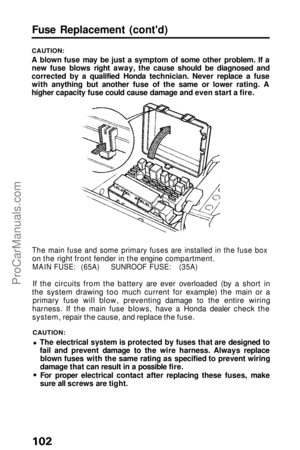 102
102 103
103 104
104 105
105 106
106 107
107 108
108 109
109 110
110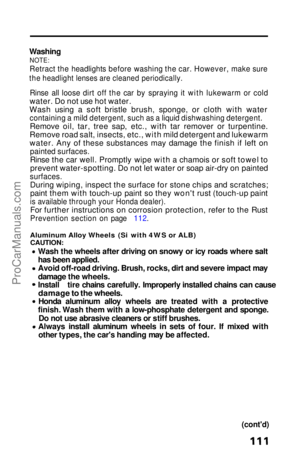 111
111 112
112 113
113 114
114 115
115 116
116 117
117 118
118 119
119 120
120 121
121 122
122 123
123 124
124 125
125 126
126 127
127 128
128 129
129 130
130 131
131 132
132 133
133 134
134 135
135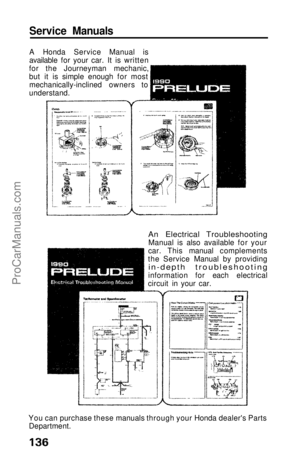 136
136 137
137 138
138 139
139 140
140 141
141 142
142

